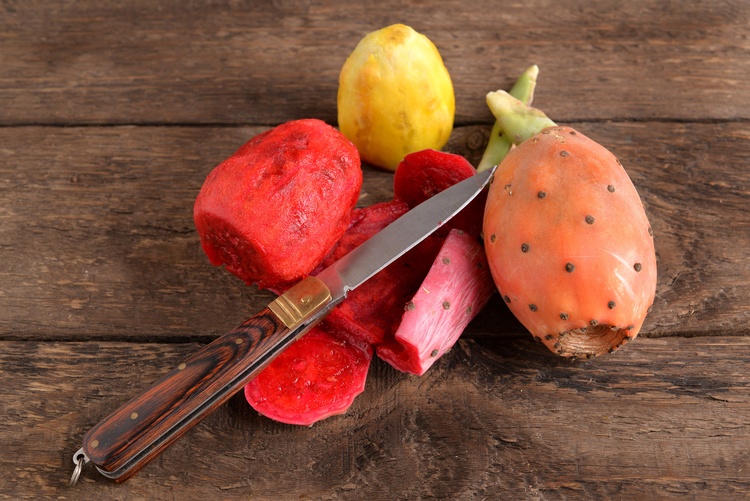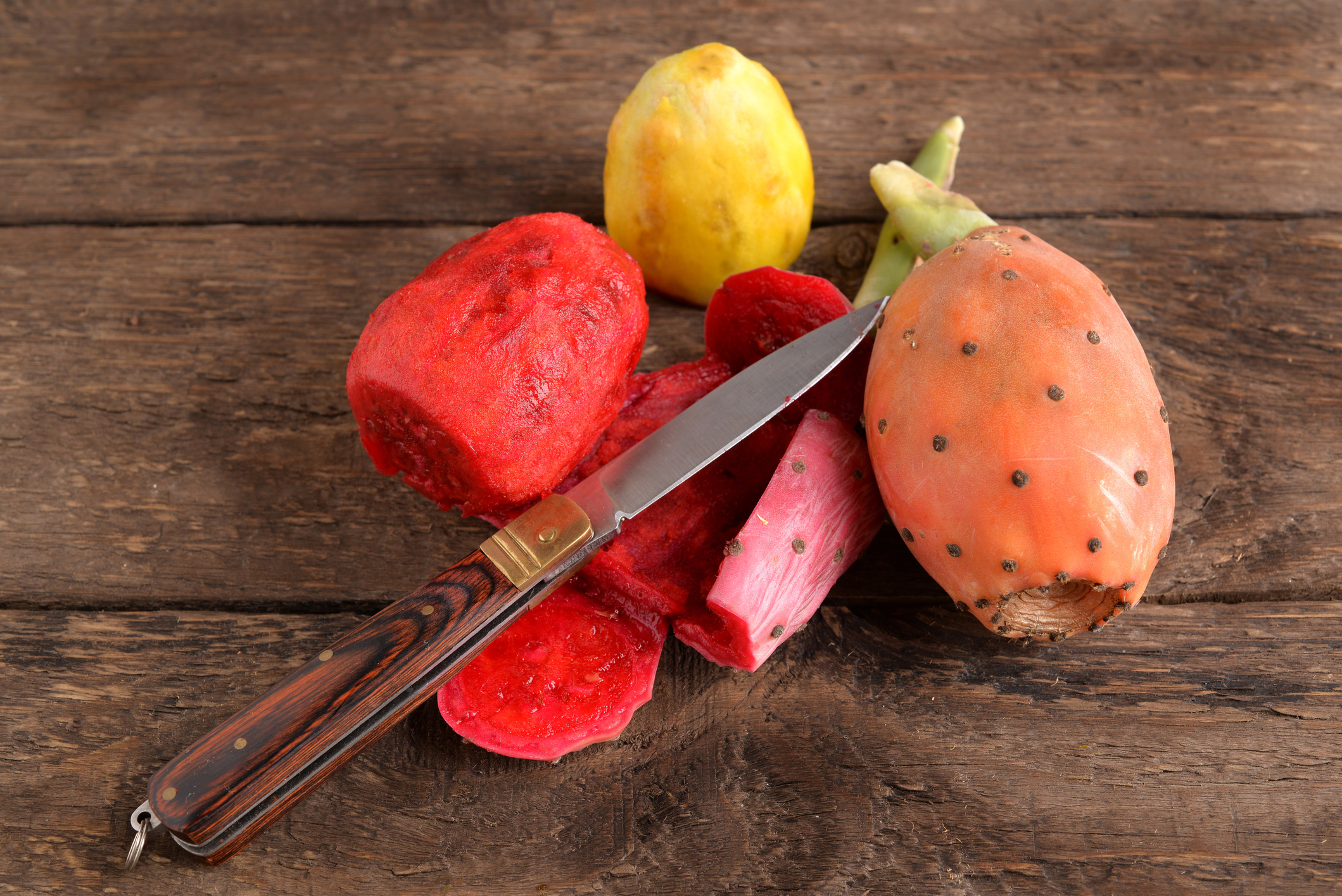Why is a fruit salad called a macedonia?
And what do prickly pears have to do with India?
Below we’ll discover the (plausible) origins of some of the more unusual food names.
BACCALÀ (Salt cod)
The Italian word for salt cod is “baccalà”, a term which comes from the Low German bakkel-jau, meaning “salted fish”, a transposition of bakel-jau, meaning “as stiff as rope”.
It could also derive from the Flemish kabeljaw, which is a stick of fish.
Similar words are used in Romance languages, for example, bacalao or baccallao in Spanish and bacalhau in Portuguese.
CLEMENTINA (Clementine)
The clementina is a citrus fruit, a hybrid between a mandarine (mandarino) and a sweet orange (arancia).
For this reason, it is also commonly called a mandarancio.
Some sources claim that the clementina originated purely by chance.
Other accounts credit Father Clément Rodier with its discovery in the garden of his orphanage in Misserghin, Algeria, at the turn of the last century.
The fruit, bearing the priest’s name, became popular in the 1940s.
Another theory has the hybrid developing generations earlier in China or Japan, and that the Algerian priest was only responsible for introducing it to the Mediterranean region.
FICO D’INDIA (Prickly pear)
The fico d’India (literally, “fig of India”) originated in Mexico and was later brought to Europe by the Spanish around the mid-1500s, immediately following the conquest of the New World.
The fico d’India bears this name thanks to Christopher Columbus.
When Columbus reached San Salvador on October 12, 1492, he thought he had discovered new territories, namely, the “Indies”.
It was Amerigo Vespucci, who, in 1501, realised that Columbus had not, in fact, found new Asian lands but rather, a new continent altogether, eventually named “America”, after Vespucci’s given name.
The prickly pear cactus found its way to the mild Mediterranean regions where it flourished.
This ideal environment contributed to the plant’s popularity, so much so, that the fico d’India has become a feature of the local landscape.
MACEDONIA (Fruit salad)
Macedonia is a salad composed of small pieces of fruit, dressed in various ways.
It probably owes its name to the Balkan Peninsula, a region characterised as comprising various populations: Greek, Bulgarian, Macedonian, Albanian, Serbian and Turkish.
In fact, in French, the word macedoine means “a mixture of different things”.
An alternative explanation dates back to an event which apparently took place during Emperor Justinian’s reign.
Antonina, wife of the valiant general Belisarius, had a lover whom she was also terribly fond of.
The general asked one of his slave-girls, whose name was Macedonia, to reveal Antonina’s affair.
Macedonia had Belisarius’ word that no harm would befall her.
Antonina, however, denied everything, even in the face of all the evidence, and Belisarius, convinced of his wife’s innocence, left Macedonia to her fate.
Antonina exacted her revenge by having Macedonia’s tongue cut out and diced into little pieces, then collected in a pouch, and thrown into the sea.
Therefore, “to make a Macedonia out of someone”, became “to make a Macedonia out of fruit”, and ultimately, the term for fruit salad.
POMODORO (Tomato)
The term pomodoro (literally, “golden apple”) has a precise meaning.
When this delicious “fruit” arrived in Europe - after the discovery of America - its shape and colour were quite different from what we
are now used to.
The tomato was a type of gold-coloured berry, hence the name pomo d’oro.
The tomato came to Italy via Spain.
It was originally only an ornamental plant, not deemed to be edible due to its high levels of solanine, a toxic alkaloid.
A few decades later, however, the tomato made a grand entrance in Italian kitchens.
PAN DI SPAGNA (Sponge cake)
According to the most believable version, the pan di Spagna (literally, “Spanish bread”) was invented by a Genoese cook employed by the noble Pallavicini family.
In the mid-1700s, the powerful Republic of Genoa sent Marquis Pallavicini to Ferdinand IV’s royal court as its ambassador.
The Marquis brought with him his most trusted servants.
Among these was a pastry chef called Giovanbattista Cabona, who went by the name of Giobatta.
The Marquis asked Giobatta to prepare a special sweet for the momentous occasion.
Giobatta created a cake which was later christened pasta genovese, to acknowledge the cook’s origins.
To this day, this cake is considered fundamental to the art of baking.
Perhaps it was because Spain did not produce any butter, over time the pasta genovese became lighter and took on the name of pan di Spagna, in honour of the Spanish court.
Airy, soft and tasty, the pan di Spagna - or Italian Génoise, as it is known in English – is the basis for countless cakes because it is so versatile: it can be flavoured in many ways and filled with different types of creams.
SAVOIARDI (Sponge fingers/ladyfingers)
Savoiardi biscuits are delicate, crisp and have an elongated form, not unlike fingers.
The separately whisked egg whites confer a remarkable lightness to the batter.
These “biscuits of Savoy” came into existence in the late Middle Ages, and according to one legend, it was Amedeo VI, Duke of Savoy, who requested his chef create a special biscuit to impress the King of France, who was visiting at the time.
Thanks to the biscuits’ resounding success, they were officially adopted by the House of Savoy, and became an extremely popular treat with the younger members of the dynasty.
A recipe from the 1500s states its ingredients: «Si fanno con poca farina, albume d’uovi e zuccaro» (“They are made with a little flour, egg whites and sugar”).
Savoiardi are also referred to as biscotti al cucchiaio (“spoonable biscuits”) because they are suitable for classic desserts like trifle and charlotte cakes, or to accompany a bavarois, vanilla or chocolate custards, ice creams and fruit salads.
MELANZANA (Eggplant)
The Arabs were the first to bring this Chinese vegetable to our tables.
The Arab name for this vegetable was badingian, which later became berenjena in Spanish and aubergine in French.
During the Middle Ages, it was common to add the prefix melo to indicate fruits or vegetables which came from afar (e.g. melograno – pomegranate, melacotogna – quince). So, badingian became melobadingian, hence, melanzana.
TIRAMISÙ
Many regions of Italy, from Piedmont to Emilia-Romagna, lay claim to this dessert made of layers of coffee-dipped sponge fingers and mascarpone cream.
Of the myriad legends regarding the origin of tiramisù, the most plausible one places it in Tuscany towards the end of the 17th century.
More precisely, in Siena, during a visit from Cosimo III de’ Medici, Grand Duke of Tuscany.
Albeit somewhat aloof, Cosimo was also fond of extravagant luxury and was known to have a sweet tooth.
The Sienese pastry chefs invented a delicacy in his honour: the zuppa del duca (“soup* of the Duke”).
Cosimo appreciated the dish so much, he took the recipe back to Florence, from where its popularity quickly spread to other regions.
In the meantime, rumours circulated that the “soup” had aphrodisiac properties.
When the recipe reached Venice, the courtiers would indulge in this special dish before every romantic rendezvous.
It is quite possible that its reputation for boosting energy and vigour contributed to its name changing from zuppa del duca to the vaguely allusive tiramisù (literally, “pull me up”).
But this is where the story takes a surprising turn.
After two years researching the mysterious origins of the tiramisù, food writers and critics Clara and Gigi Padovani managed to find definitive proof that the famous Italian dessert has its roots in the Friuli region, not Veneto, let alone Tuscany: in fact, precisely between the towns of Pieris (Gorizia) and Tolmezzo (Udine).
In 2017, the Ministry of Agricultural, Food and Forestry Policies included the renowned sweet in its PAT list (traditional Italian food products which gain official approval) ascribing the recipe to the Friuli-Venezia Giulia region.
It even comes in two versions: the one which traces its origins to the 1950s, at the Roma hotel-restaurant in Tolmezzo, and the semifreddo version, known as the Vetturino Tìrime Su, also served in the 1950s, at the Vetturino Trattoria in Pieris.
ZUPPA INGLESE (Trifle)
Hot on the heels of tiramisù, the most controversial dessert has to be zuppa inglese (literally, “English soup”*).
For those who don’t know its history, it can seem logical, given its name – English soup – that it originated in the Anglo-Saxon world.
England, however, has very little to do with it.
The zuppa inglese is quintessentially Italian and especially common in the Emilia-Romagna region.
Its ingredients are basically pan di Spagna (sponge cake), crema pasticciera (custard/pastry cream) and liqueur.
But there are as many versions as there are theories about its provenance.
The first theory suggests that the zuppa inglese came into being in the Estense Court in the 16th century, as a reworking of the English trifle, which was then made with leftover cake and served with tea.
A representative of the Estense Court, upon his return from a mission in London, apparently asked the pastry chefs to prepare him a trifle.
The cooks used a popular plain cake of the time, instead of the leavened cake dough used in England.
They soaked it in Rosolio (a type of Italian liqueur derived from rose petals) and Alchermes (a syrupy and aromatic dark red liqueur) and filled it with custard cream.
The cake was replaced by the pan di Spagna in the 17th century.
According to another tale, the zuppa inglese saw the light in 19th-century Tuscany, thanks to the governess of an English family residing in Florence.
The woman prepared a zuppa* with leftover biscuits, dipped in sweet wine and the addition of pastry cream and chocolate pudding.
A third version places the Italian trifle in the 19th century, when the recipe appeared in the famous cookbook La scienza in cucina e l’arte di mangiar bene (“Science in the Kitchen and the Art of Eating Well”) by the father of Italian cooking, Pellegrino Artusi.
Artusi alludes to a substantial difference between the two versions and possibly lays claim to its authenticity in the same way that the Tuscans consider the tiramisù’s ancestor, the zuppa del duca, a Sienese creation.
What we do know for sure is that towards the end of the 1800s, the Italian trifle was made and consumed in at least three regions - Emilia-Romagna, Tuscany and Marche – and each of these takes credit for its invention.
Professor Giovanni Ballarini suggests looking in the Emilia area to find the zuppa inglese’s beginnings.
More precisely, in Parma, where Austrian archducchess Marie Louise reigned in the early 1800s.
Royal confectioner, Vincenzo Agnoletti, an enterprising Roman cook who is said to have reinvented the local layered dessert called marangone, by dousing it in rum, the beverage adopted by British sailors.
When you consider the ingredients of this dessert - Italian Génoise and sponge fingers from Piedmont - rather than zuppa inglese, a more fitting moniker would be zuppa italiana.
In fact, in English, it is called precisely that: Italian trifle!
*(Zuppa is often translated as “soup”.
It seems quite odd that a dessert would be called a soup.
Actually, zuppa derives from the word inzuppare, meaning “to dunk” or“to soak”.
And rightly, zuppa referred to dishes featuring pieces of bread or cake set to soak in a savoury or sweet liquid).












